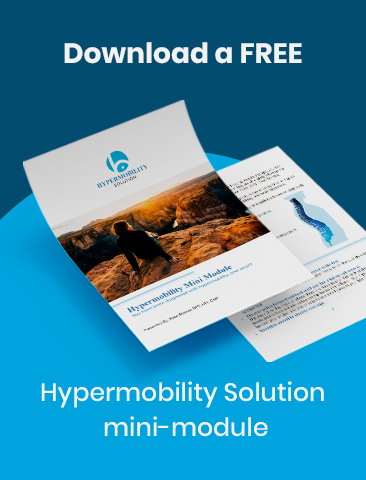May is Hypermobility and EDS Awareness Month, and with that, I want to touch on how to explain your complex condition accurately and effectively to friends and family in order to raise awareness.
In this article, I’ll discuss a few different tactics to help you accurately and effectively explain your condition and symptoms to others. Read on to learn more.
- Friends and Family
- Coworkers
- Finding support
Explaining Your Complex Condition to Friends and Family
Explaining your complex condition to friends and family can be approached in two different ways.
Approach One
Keep things broad and simple. Often, our hypermobility can be overwhelming to explain due to its complex nature. Some people are better at understanding these types of complex conditions than others.
So, when explaining your complex condition to friends and family, you will want to get a read on their understanding of your diagnosis and symptoms in order to determine the level of detail in which you want to provide surrounding your condition.
If your friend or family member is not incredibly familiar with hypermobility, or related complex conditions, sometimes keeping the conversation around the topic broader, can be better.
If this is the approach you decide to take, you can simply start the conversation by bringing up the fact that you have pain, an issue with, or simply just a problem and you’re working on managing your symptoms.
Oftentimes, this is more than enough for most. And, with this information, your friends and family will more than likely want to support you.
If you can provide them with suggestions or ways that they can help you (and it doesn’t have to be just physically), they will more than likely be very willing to help.
Before you have this broad conversation with a friend or family member, you may want to think to yourself about different ways that the individual that you’re explaining your condition to can help you.
That way, you’re prepared and they can feel as though they are lending a helping hand.
Approach Two
This approach should be used more so with a family member or friend that we feel comfortable sharing more in depth details with.
When explaining your condition more in depth, you only need to provide the information that you feel comfortable giving.
Feel free to share what you’re going through, but you absolutely do not need to feel obligated to tell your entire story, unless you choose to do so on your own.
Explaining Your Complex Condition to Coworkers
Explaining your complex condition to coworkers can be a little bit more tricky than explaining to family or friends, but it does not have to be difficult.
Again, you may want to take the first approach mentioned: only supplying enough information to inform, but not too much so that you don’t feel comfortable.
Due to the fact that your coworkers will be engaging with you in different conversations and tasks than people such as your family and friends, your conversation may look different in a few different ways.
Only Divulge Information That You Are Comfortable Sharing
When explaining your condition or syndrome to your coworkers, keep it short, sweet, and to the point. Your coworkers don’t need to know every detail. They just need to be aware of the situation so that they can be of help to you.
One of my favorite things to do before I know this type of conversation will take place, is to create what I call “catch-phrases”.
These are phrases that I use to explain my condition or what I am (or am not) capable of doing due to my hypermobility in a work environment.
For instance, you can say something along the lines of:
“I have a connective tissue disorder where my joints move more than they’re supposed to. This disorder makes moving and doing things quite a bit harder for me and I may ask you for some additional help every now and then.”
You can also blame your hypermobility on a joint injury by using a catch-phrase along the lines of:
“I have a bad back.” Or, “I have a shoulder issue.”
Then, follow up that statement with a way that your coworker can help. For example,
“I have a shoulder issue that acts up. I may ask you for help moving boxes or reaching things, just to let you know.”
You don’t have to explain your entire situation. But, informing others that you may need a little extra help with a few things will help them better understand.
This way, they can help you without having to have a long and personal conversation about your condition.
If you figure out these phrases, you’ll be setting yourself up for a helpful and constructive explanation of your condition with the transparency needed to get help without oversharing.
-
Think About How Others Can Help You
Another tip that I like to give is to really take the time to think about ways that others can help you. Be intentional about the support that you ask for.
Try to take a look at your work environment, your job description, and the tools that you use at your position daily. - Then, think critically about what actions within your job description may require a little extra help, which tools should be modified, or if there is a way to make things easier for you overall. It truly may be something as simple as asking a coworkers to move the boxes from the top of the shelf in the supply room to one that is easily reachable for you.
- Try to think critically about the helpful help that you could potentially need.
And, when you explain that you need help moving, lifting, etc. remember to keep your explanation short and simple.
Pick a description that you identify with, like, “my shoulder dislocates when I lift something that’s too heavy.” Or, “I sublux when I move things like that.”
Find a description that works for you and keep it short and simple. And stand by it! - Don’t ever put yourself in a situation where you could risk injuring yourself.
Help The People In Your Life Help You
By taking the time to explain your complex condition, whether it’s a brief catch-phrase or a longer, more in depth conversation, you’re raising awareness and advocating for yourself and others who have hypermobility and other similar or related complex conditions.
You should never feel obligated to completely explain your condition (unless you are wanting to do so on your own volition).
But, by bringing up your condition, you’re allowing for others to understand your condition, along with others who have hypermobility.
When you do so, you’re raising awareness, helping make your own life easier, and helping others’ lives as well.
Still have questions? You can check out my video on explaining your condition to friends, family, and coworkers here.
Looking for an online support team? Join the Hypermobility Solution Facebook Group here!

About Kate

Kate Skinner is a Doctor in Physical Therapy, co-founder of Great Divide Physical Therapy, and creator of Hypermobility Solution.
Recent Posts





